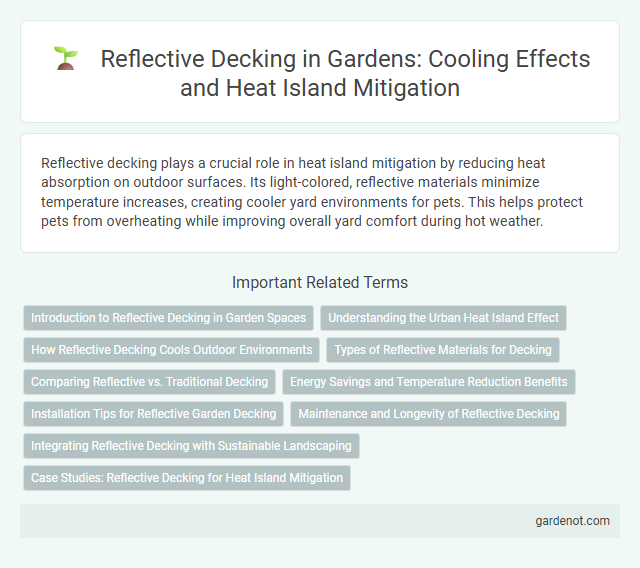Reflective decking plays a crucial role in heat island mitigation by reducing heat absorption on outdoor surfaces. Its light-colored, reflective materials minimize temperature increases, creating cooler yard environments for pets. This helps protect pets from overheating while improving overall yard comfort during hot weather.
Introduction to Reflective Decking in Garden Spaces
Reflective decking in garden spaces significantly reduces surface temperatures by using materials with high solar reflectance and thermal emittance, mitigating urban heat island effects. These decking surfaces enhance outdoor comfort by reflecting sunlight and minimizing heat absorption compared to traditional wood or composite decks. Incorporating reflective decking promotes energy efficiency and supports cooler microclimates within residential and commercial landscapes.
Understanding the Urban Heat Island Effect
Reflective decking plays a crucial role in mitigating the urban heat island effect by reducing surface temperatures through high solar reflectance and thermal emittance. Materials such as cool roofs and light-colored composites significantly decrease heat absorption, thereby lowering ambient temperatures in urban environments. Studies show that reflective decking can reduce surface temperatures by up to 30degF, contributing to improved outdoor comfort and decreased energy consumption.
How Reflective Decking Cools Outdoor Environments
Reflective decking significantly reduces surface temperatures by reflecting a higher percentage of solar radiation compared to traditional materials, thereby mitigating heat absorption in outdoor environments. By lowering deck surface heat, it helps decrease the surrounding air temperature, contributing to overall urban heat island mitigation. This cooling effect enhances comfort and reduces energy consumption from nearby air conditioning systems.
Types of Reflective Materials for Decking
Reflective decking materials commonly include light-colored composite boards, aluminum, and specially coated wood that minimize heat absorption by reflecting solar radiation. High-albedo surfaces like thermoplastic polyolefin (TPO) and cool deck paints with reflective pigments enhance thermal performance and reduce surface temperatures. These materials contribute significantly to urban heat island mitigation by lowering deck surface temperatures and improving outdoor comfort.
Comparing Reflective vs. Traditional Decking
Reflective decking reduces surface temperatures by up to 30% compared to traditional wood or composite decks, significantly mitigating urban heat island effects. Its high albedo material bounces solar radiation away, decreasing heat absorption and lowering ambient temperatures around outdoor spaces. Traditional decking absorbs and retains heat, often increasing local temperatures and contributing to discomfort during warmer months.
Energy Savings and Temperature Reduction Benefits
Reflective decking significantly reduces surface temperatures by reflecting solar radiation, which lowers heat absorption in urban yards and contributes to mitigating the heat island effect. This reduction in heat absorption decreases the need for air conditioning, resulting in substantial energy savings and lower utility costs. Studies show reflective materials can reduce surface temperatures by up to 30%, enhancing outdoor comfort and supporting sustainable heat island mitigation strategies.
Installation Tips for Reflective Garden Decking
Proper installation of reflective garden decking starts with selecting light-colored, high-albedo materials to enhance solar reflectance and reduce heat absorption. Ensure the decking surface is clean and smooth before applying reflective coatings to maximize their effectiveness. Position decking boards with adequate spacing for ventilation, which helps dissipate heat and prolongs the lifespan of reflective surfaces.
Maintenance and Longevity of Reflective Decking
Reflective decking offers superior heat island mitigation by significantly reducing surface temperatures, which directly contributes to extending the material's lifespan through decreased thermal stress. Proper maintenance, including regular cleaning to prevent dirt buildup and inspections for UV damage, ensures optimal reflectivity and durability over time. The combination of high-quality reflective coatings and routine care minimizes degradation, resulting in long-lasting performance and sustained energy savings.
Integrating Reflective Decking with Sustainable Landscaping
Reflective decking significantly reduces heat absorption by utilizing materials with high albedo, lowering surface temperatures in urban heat island mitigation projects. Integrating reflective decking with sustainable landscaping enhances energy efficiency by complementing native plants that provide shade and improve air quality. This combination promotes cooler outdoor environments and supports long-term ecological balance in urban yards.
Case Studies: Reflective Decking for Heat Island Mitigation
Reflective decking materials have demonstrated significant effectiveness in heat island mitigation by reducing surface temperatures in urban outdoor spaces. Case studies reveal that using light-colored, high-albedo decking reduces heat absorption by up to 40%, leading to cooler ambient temperatures and improved thermal comfort. Projects in metropolitan areas like Phoenix and Los Angeles report a decrease in surrounding air temperature by 2 to 3 degrees Celsius, showcasing reflective decking as a sustainable strategy for urban cooling.
Reflective decking Infographic

 gardenot.com
gardenot.com